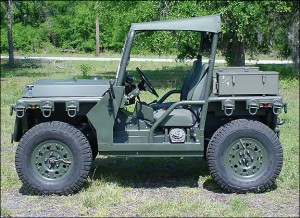Husbanding our Military Dollars
BY Herschel SmithThe Obama administration has called for a 10% decrease in military spending to begin in fiscal year 2010. At The Captain’s Journal, calling this irresponsible would be an understatement, and less than our readers have come to expect. It’s just plain dangerous, considering the ongoing campaign in Afghanistan, Iraq being a likely protectorate of the U.S. for years to come, the resurgence of Russia flexing its muscle in Georgia and the Black Sea and Caspian regions, the growth of China and its naval forces, the need for growth of the size of both the Army and Marine Corps, and many other needs and dangers in the world as it now exists.
Then along comes a report like the one on the Internally Transportable Vehicle.
The Marine Corps is starting to deploy a jeeplike vehicle called the Growler, 10 years after conception and at twice the contract price, after delays that were caused by changing concepts and problems in contracting, development and testing, according to two reports …
The idea for such a vehicle was developed in 1999 by the Marine Corps, which wanted a vehicle that could be carried in the V-22 Osprey aircraft to support assault operations and that would tow a 120 mm mortar and an ammunition trailer.
Today, instead of one vehicle that could serve both functions, there are two — one for reconnaissance and a shorter version that tows the mortar and ammunition trailer — built by the same company.
The first Growlers in the mortar program — officially called internally transportable vehicles, or ITVs — have been deployed to Marine units, but with limited combat capabilities. Because of their light armor and ammunition safety problems, “you can’t run it up the highway in an urban area such as Iraq,” said John Garner, the Marines’ program manager for the vehicle. “But it could accompany foot-mobile Marine infantry in a not-built-up area such as Afghanistan,” he added.
The inspector general report said that the average cost of a single Growler has risen 120 percent, from about $94,000 when the contract was awarded in 2004 to $209,000 in 2008. The unit cost for the vehicle with mortar and ammunition trailer has grown 86 percent, from $579,000 to $1,078,000 …
… after the contract was awarded, Garner said, “there were significant additions made for capability.” For example, an air suspension had to be added to allow the Growler to get on and off the Osprey because it could raise and lower its height. The makers added a new cooling system, power steering and power brakes, along with a beefed-up General Motors engine similar to the one used in the GMC Yukon. Altogether, Garner said, about $50,000 of the cost growth was in additional off-the-shelf items that now permit the Growler to travel up to 45 mph on a highway.
To be fair, this concept wasn’t created out of nothing. It goes hand in hand with the Osprey V-22, Amphibious Assault Docks and the expeditionary force structure that the Marines seek. Also to be fair to the Marines, the Army has some on order as well.
But it’s time for some straight talk. Here is how it happens. Performance specifications are written. Request for quotes are sent out to potential contractors, and bids are received and evaluated. They are evaluated based on cost, which ones most closely adhere to the performance specifications, and so forth. A contract is awarded, and rather than simply adapting the forces to the contract, the practice is to adapt the contract to every request for a modification.
It is the last part that adds cost, and the first part that causes price to be so high to begin with. For the price of the Growler one could go down to the local auto dealership and order up eight to ten jeeps. Doing so would require that unit-based enlisted men figure out a way to load them onto the V-22s with ramps, jacks, winches, or other means.
The Marines are, after all, supposed to be able to improvise, adapt and overcome. The reflexive tendency for advocates for the military (like The Captain’s Journal) is to defend the program. “But wait, you don’t understand, there are requirements that must be met in a war zone, there are compatibility issues, it just isn’t that simple.”
But in fact it is that simple. We must learn to make do with less, even if the defense budget is not cut. We must learn to husband our resources so that they will go further, arming the U.S. military to remain the best and best-equipped in the world.
If this requires the use of duct tape, cable ties, winches, hoists, bungee cords, jacks and chain falls, then so be it. When we spend this much money on a vehicle, something else goes wanting, such as badly needed lighter body armor, open bolt designs for SAWs, and so on. We simply cannot spend $200,000 on a 4WD vehicle and continue to be the best armed military in the world.
The program manager should be aghast as the cost of the vehicles, and should never have let it enter the production phase. It’s not a matter of funding the military. It’s a matter of putting the funding in the right place and husbanding our resources. Every family member on a budget does this every day, and it isn’t unreasonable to expect that military equipment design programs do it too.






On March 14, 2011 at 8:06 pm, Chrith said:
Without knowing the precise specs, it seems they could have simply put together a modified WWII Jeep and got better performance for much less money. I suspect an off-the-shelf Yamaha Rhino or Polaris Ranger would have similar capability as this little guy, and cost MUCH less. Although if the articles I read are correct, and it has a Chevy V-8 in it, that is impressive. And interesting.